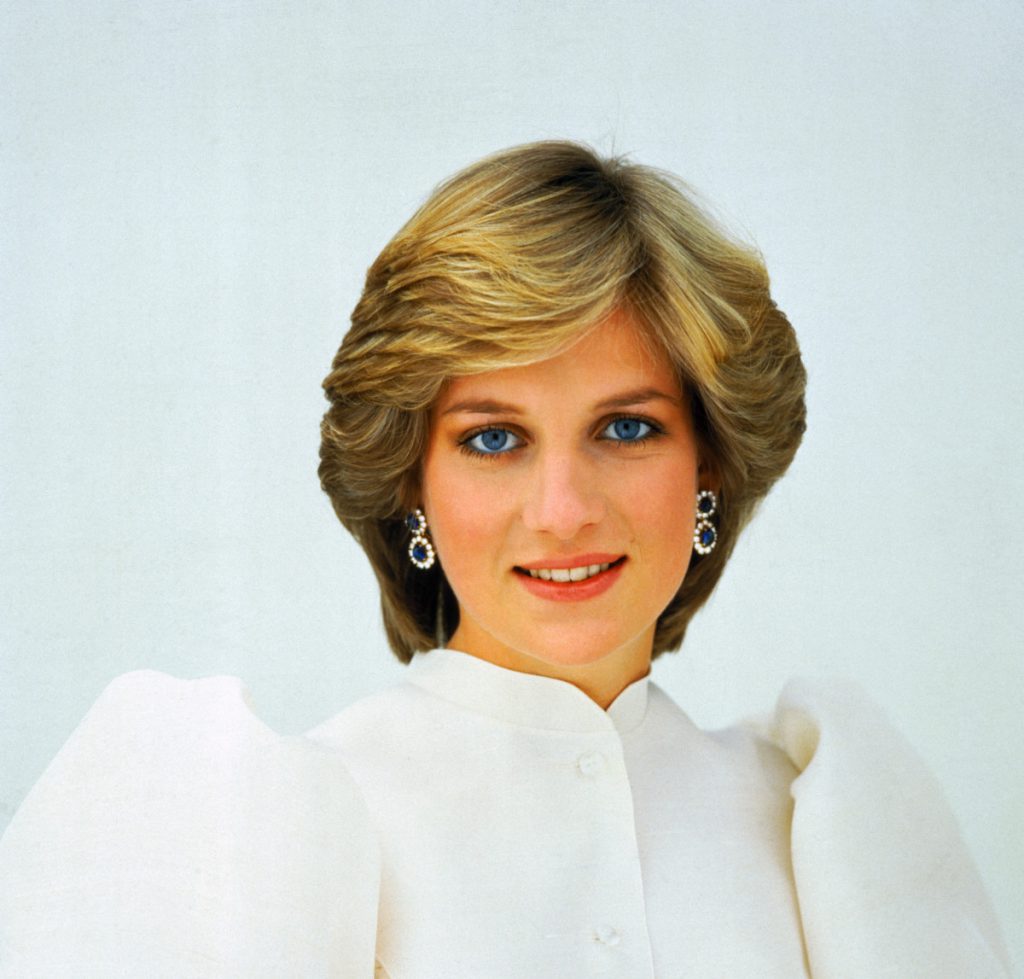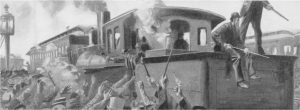Winner of the Fall 2019 StMU History Media Award for
Best Article in the Category of “People”
Two million people are cheering her name, 750 million eyes are upon her. She’s smoothing out her silk, ivory colored wedding dress embroidered with pearls and mother-of-pearl sequins. She is being transported to St. Paul’s Cathedral by five military police officers in a fairytale-like coach. Keeping her composure, she steps out of the stagecoach in her Cinderella-like wedding slippers. She walks up the steps of the Cathedral, head held high, the Spencer family tiara decorating her gorgeous short, blonde hair. As she enters the dome, all eyes are drawn to her glowing, innocent features and the twenty-five-foot train trailing behind; the opening song is played by one of the three orchestras that her fiancé has chosen. The date is July 29, 1981, marking the wedding of Prince Charles to Lady Diana. Diana knew that becoming Princess of Wales was going to be a great responsibility, one that couldn’t be taken lightly. She strongly believed it was either going to be a fairy-tale dream come true or a total nightmare; either way, it was too late that day for her to change her mind.1

Charles was absent for a lot of the first year of their marriage: he tended to his royal duties, participated in shooting, polo, and painting pictures. He lived a comfortable, no strings attached life with Diana that first year. Once, he even admitted to his past liaisons with some married women. They were deemed a “safer choice” because they would keep quiet—due to having families and husbands. Charles assumed Diana would fit perfectly into his lifestyle like a missing puzzle piece. This was not the case, as Diana and he had very different forms of entertainment and pastimes; there was also a rather large age gap of fourteen years.3 During their engagement, when Diana was nineteen and Charles was thirty-three, Prince Charles received a package. Diana, already suspecting Charles was hiding something, found a gold bracelet addressed to ex-lover Camila Parker-Bowles with the initials “F” and “G” intertwined; the initials were of the nicknames they had given to each other.4 “This was about two weeks before we got married…. So rage, rage, rage! ‘Why can’t you be honest with me?’ But, no, [Prince Charles] cut me absolutely dead.”5 Charles denied the accusations, making her feel paranoid and leaving her with second thoughts about marriage. Diana claimed she had considered canceling the wedding, discussing the situation with her two sisters, both responding with “your face is on the tea-towels so you’re too late to chicken out now.”6

The public viewed the wedding with a lot of admiration, so much that it blindsided them. The public was completely unaware that Diana could not handle the public scrutiny; her face was on every magazine cover and she was all the media talked about. Princess Diana was portrayed as calm and very put-together; she carried herself in a way that didn’t expose her weaknesses. This was the very mindset of the royal family, any form of unwanted exposure was immediately hidden or covered up, and she learned this a little too late. The wedding that was perceived as “a ceremony that bore the weight of centuries of national tradition” had a tragic story behind it.7
Diana would frequently visit the kitchen where she would participate in binge eating behaviors, such as eating endless bowls of ice cream and special snacks at request. Staff and friends were concerned about Diana’s dietary habits; she was so thin despite consistently raiding the fridge and eating excessive amounts of food in one sitting. Although they would frequently see her overindulge in food, Diana would make herself throw up five to six times a day. Diana claimed that her disorder was first triggered because of a comment Prince Charles made.8 “My husband put his hand on my waistline and said, ‘Oh, a bit chubby here, aren’t we?’ and that triggered off something in me—and the Camilla thing, I was desperate…. I remember the first time I made myself sick.”9

Diana started slipping into the deep end; her first pregnancy was tough on her body. Apart from morning sickness, Diana suffered from bulimia. Bulimia nervosa is characterized by recurrent episodes of binge eating followed by compensatory behaviors to prevent weight gain by self-induced vomiting, fasting, or excessive exercise. The onset of bulimia nervosa can be due to stressful life events and usually develops between adolescence and early adulthood. There is an increase in depressive symptoms and depressive disorders in affected individuals as well as a higher suicide risk. Mood disturbance begins at the same time or during the development of the eating disorder, but in other individuals, predates the illness.10
Diana became desperate; she would run around with a lemon knife. Diana knew something was wrong with her but didn’t know how else to ask for help. When she did reach out for help, Charles thought Diana was crying wolf and dismissed her threats. Charles became alarmed and overwhelmed by Diana’s frequent mood swings, her consistent crying, and obsession with his old mistress, Camilla Parker Bowles. He believed that she was being immature and seeking attention, so instead of helping his wife, he went riding on the Sandringham estate. Diana almost felt challenged by his response, so at two months pregnant, Diana placed herself at the top of a wooden staircase in Sandringham and threw herself down the stairs.11 “Very, very difficult pregnancy indeed. Sick the whole time, bulimia and morning sickness…. I didn’t know which way to turn at all…. Charles said I was crying wolf and I said I felt so desperate, and I was crying my eyes out, and he said, ‘I’m not going to listen. You’re always doing this to me. I’m going riding now.’ So I threw myself down the stairs.”12
Some could claim that Diana was immature and naive and in reality, she was just a child. Diana had just become a young adult when they were married; she still had an illusion of a perfect marriage, one that wouldn’t suffer from difficulties. Her mindset was heavily influenced by her childhood; Diana’s parents’ troubled marriage and their frequent fights, even after their divorce. She didn’t want her marriage to end up like her parents. Diana believed that a Royal marriage would complete the pretty picture she painted in her head, it couldn’t possibly be any less than perfect—after all, that is what she had read in novels.13
At this point, Diana knew that she wasn’t going to get what she wanted or what she needed: stability and compassion. Instead, she was being scorned and her feelings were minimized. “I was thrown into the deep end,” she said of royal life. “Nobody ever helped me at all.” This incident was one of many cries for help during their first year of marriage.14
Diana made several other threats to her life; she began engaging in self-mutilation. In one incident Diana threw herself against a glass display cabinet at Kensington Palace and shortly after, slashed her wrists with a razor blade. Even during an argument with Prince Charles, she picked up a penknife and cut her chest and thighs.15 Still, Diana kept up a happy-go-lucky persona for the public and continued her duties as Princess of Wales. In the midst of a troubled time, she grew and matured; she found herself. Even if Charles solely wanted to please his parents by marrying Diana when his heart belonged to someone else, she was beloved by so many and the public saw her as one of their own. Diana was one of the only Royals that didn’t make the masses feel like less than they are.16 She was able to find herself through the volunteer work she engaged with and by connecting to the public.17
Diana was perceived as having it all, being the “It Girl” only to be revealed that within those palace walls, she was living a nightmare.
- Anne Matheson, “A Day of Splendour and Romance,” Australian Women’s Weekly (2018): 48. ↵
- Barbara Cartland, “Royal Marriage: When Life isn’t a Romantic Novel,” Newsweek 120 (1992): 72. ↵
- A Biographical Encyclopedia, 2002, s.v. “Women in World History,” 591. ↵
- Andrew Morton, Diana: Her True Story (New York: Pocket Books, 1992), 90. ↵
- Andrew Morton, “Diana’s Secret Tapes,” People 88 (2017): 88. ↵
- Andrew Morton, Diana: Her True Story (New York: Pocket Books, 1992), 91. ↵
- Barbara Cartland, “Royal Marriage: When Life isn’t a Romantic Novel,” Newsweek 120 (1992): 72. ↵
- Andrew Morton,Diana: Her True Story (New York: Pocket Books, 1992), 96. ↵
- Andrew Morton, “Diana’s Secret Tapes,” People 88 (2017): 88. ↵
- American Psychiatric Association, Diagnostic and Statistical Manual of Mental Disorders Fifth Edition (Arlington, VA: American Psychiatric Association, 2013), 345-347. ↵
- Andrew Morton, Diana: Her True Story (New York: Pocket Books, 1992), 104-105. ↵
- Andrew Morton, “Diana’s Secret Tapes,” People 88 (2017): 88. ↵
- Barbara Cartland, “Royal Marriage: When Life isn’t a Romantic Novel,” Newsweek 120 (1992): 72. ↵
- Andrew Morton, “Diana’s Secret Tapes,” People 88 (2017): 88. ↵
- Andrew Morton, Diana: Her True Story (New York: Pocket Books, 1992), 105. ↵
- Martha Duffy, “Fractured Fairy Tale,” Time Magazine 147 (1996): 60. ↵
- Encyclopedia of World Biography, 2004, s.v. “Diana Princess of Whales,” 531. ↵



102 comments
Fatima Esparza
Princess Diana is one of my favorite royal family members in the U.K. It is sad knowing that she went through a lot as a child, and all she wanted was to love and be loved the way she never was when she was young. Charles did not give her the life she deserved, and she ended up suffering when she deserved everything good. Princess Diana should be looked up to and is an excellent example of what it means to be a humanitarian.
Ana Barrientos
Princess Diana is truly an icon, she was such a genuine soul… she cared a lot about her children and protected them. I never knew that Diana had so many struggles, it breaks my heart that all she wanted was love but Charles would ignore her and had an affair with an ex-lover. She was going through so much during her first pregnancy and nobody helped her. I can’t imagine how she felt, it must’ve been so lonely and scary to be going through it by yourself. Diana has left an impact on the world, and she is truly missed by many. Overall, great job!
Victorianna Mejia
Amazing. I have always loved Princess Diana, and I have always thought she was a great role model. She was brave. and she loved her sons with everything she had. I can’t imagine what people would have thought back then if they knew this about the royal family and their treatment of her. Also, for some reason, I hadn’t realized the age gap between her and Prince Charles. Again, amazing article. Congratulations on the award as well, it is well deserved!
Velma Castellanos
Congratulations on your best article of people. Diana is a very strong women. Reading the article made me very sad because she was living a nightmare and everyone ignored her cries. She was struggling with herself and needed guidance to feel better. Her husband was wrong for ignoring her the way he did along with the rest of the people she confided in. Her life was far from perfect and it makes me feel so sad for what she had to go through. Having your dreams taken from you at such a young age, is a big weight on your shoulders. Overall, this article truly showed the cruelty Diana had to go through.
Claire Saldana
Every year new information comes out about Diana and her horrible life behind walls. I find her persistence so encouraging. I knew she had mental health troubles but I did not know it was to this extent. I see why she did what she did and it was all completely valid. She was a kid coming into a life she thought would be perfect when it was actually a life of having everyone ignore you. They saw her as a baby maker and that’s it. I’m curious what the aftermath would have looked like if she had been successful in killing herself rahter then being murdered. I wonder how citizens would have reacted towards the royal family since they adored Diana. It’s sad to think tragic events like this have to occur for people to see they are treating others horribly.
Charles Lares
A marriage that has trouble since day one has many questions to ask rather than have an unhappy life. For Diana who wanted a fairy tale wedding but that was understanding since she had a rocky childhood. Diana would go through a hard time without her husband, Prince Charles by her side. Princess Diana endured stress and depression which could have been weakness in the eyes of the Royal Family. For someone to go through so much negativity alone and not have support from her husband is disappointing. the use of her own quotes gives us such an insight into her life and how she felt during those times really puts us in her shoes. It’s still sad that she lost her life very young almost makes me fell like she was still alone.
Irene Urbina
Amazing award! Definitely award worthy. I always looked up to Princess Diana because she was someone who seemed genuine and was a mother who always tried to be there for her sons. This article shows that the ideas that people sometimes have about royalty are not true and that if something does not seem perfect, they are dismissed. I was amazed by the struggles that Princess Diana had to face at such a young age even before she was married into the royal family and even after that she could not get the love she was seeking for, but still found ways to be happy while serving the community and connecting with them.
Mckenzie Gritton
Such a well written article! Great detail! I learned a lot about Princess Diana and the way she was treated. Its heartbreaking that she was crying for help but her own husband wouldn’t help her. All she wanted was the love she dreamed of but instead was filled with regret. It made me mad to see that she confided in her sisters about her reservations of getting married and they blew her off saying that her face is already on the tea towels. It was so messed up of them. Once again great article!
Maria Luevano
What a great article! Congratulations on the award! I always love learning more about Princess Diana because I feel like she was easily the most relatable royal to an average person’s life. Royals are always portraying their perfect families and relationships, so with Diana and Charles, it was far from perfect. The affair, the hard pregnancy, bulimia, etc. are all what make Diana stand out because her struggles are very real problems that anyone can face. Amazing job writing her story!
Lauren Castaneda
This article was nicely composed with a deep insight to Princess Diana’s life. I personally have always loved Diana but had no idea that she would inflict self harm upon herself due to the absence of Charles. Princes Diana deserved more than what was given to her, and I think the difference in age was the biggest threat to their marriage. All Diana had wanted was to fill the void with a love she longed for all her life and in the end, she was never able to receive it.